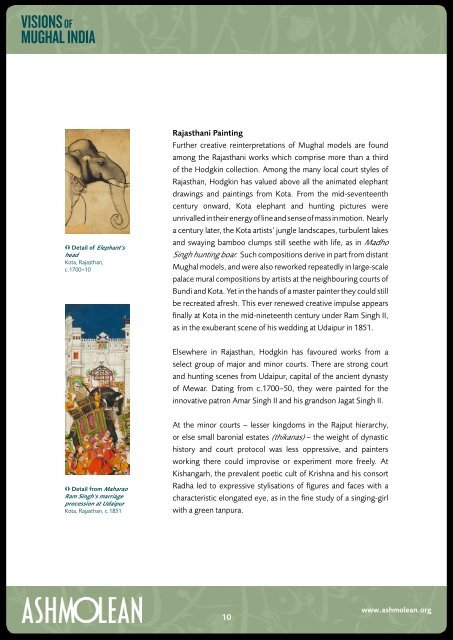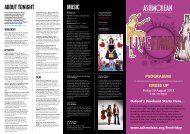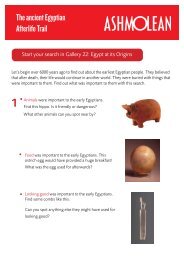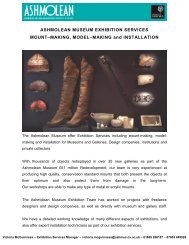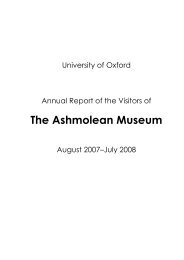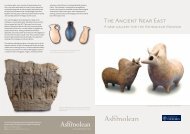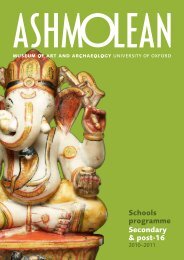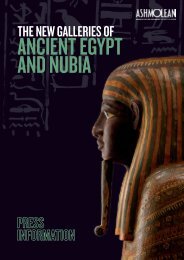visions of mughal india - The Ashmolean Museum
visions of mughal india - The Ashmolean Museum
visions of mughal india - The Ashmolean Museum
- No tags were found...
You also want an ePaper? Increase the reach of your titles
YUMPU automatically turns print PDFs into web optimized ePapers that Google loves.
VISIONS OFMUGHAL INDIA Detail <strong>of</strong> Elephant’sheadKota, Rajasthan,c.1700–10Rajasthani PaintingFurther creative reinterpretations <strong>of</strong> Mughal models are foundamong the Rajasthani works which comprise more than a third<strong>of</strong> the Hodgkin collection. Among the many local court styles <strong>of</strong>Rajasthan, Hodgkin has valued above all the animated elephantdrawings and paintings from Kota. From the mid-seventeenthcentury onward, Kota elephant and hunting pictures wereunrivalled in their energy <strong>of</strong> line and sense <strong>of</strong> mass in motion. Nearlya century later, the Kota artists’ jungle landscapes, turbulent lakesand swaying bamboo clumps still seethe with life, as in MadhoSingh hunting boar. Such compositions derive in part from distantMughal models, and were also reworked repeatedly in large-scalepalace mural compositions by artists at the neighbouring courts <strong>of</strong>Bundi and Kota. Yet in the hands <strong>of</strong> a master painter they could stillbe recreated afresh. This ever renewed creative impulse appearsfinally at Kota in the mid-nineteenth century under Ram Singh II,as in the exuberant scene <strong>of</strong> his wedding at Udaipur in 1851.Elsewhere in Rajasthan, Hodgkin has favoured works from aselect group <strong>of</strong> major and minor courts. <strong>The</strong>re are strong courtand hunting scenes from Udaipur, capital <strong>of</strong> the ancient dynasty<strong>of</strong> Mewar. Dating from c.1700–50, they were painted for theinnovative patron Amar Singh II and his grandson Jagat Singh II. Detail from MaharaoRam Singh’s marriageprocession at UdaipurKota, Rajasthan, c.1851At the minor courts – lesser kingdoms in the Rajput hierarchy,or else small baronial estates (thikanas) – the weight <strong>of</strong> dynastichistory and court protocol was less oppressive, and paintersworking there could improvise or experiment more freely. AtKishangarh, the prevalent poetic cult <strong>of</strong> Krishna and his consortRadha led to expressive stylisations <strong>of</strong> figures and faces with acharacteristic elongated eye, as in the fine study <strong>of</strong> a singing-girlwith a green tanpura.10www.ashmolean.org


